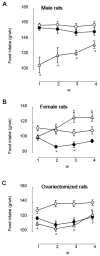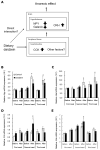Mechanism of Soy Isoflavone Daidzein-Induced Female-Specific Anorectic Effect
- PMID: 35323695
- PMCID: PMC8955737
- DOI: 10.3390/metabo12030252
Mechanism of Soy Isoflavone Daidzein-Induced Female-Specific Anorectic Effect
Abstract
Epidemiological studies suggest that regular intake of soy isoflavone exerts a preventive effect on postmenopausal obesity and other forms of dysmetabolism. Estrogens inhibit eating behavior. Soy isoflavones may act as estrogen agonist in estrogen-depleted conditions, whereas they may either act as an estrogen antagonist or be ineffective in estrogen-repleted conditions. We investigated the effects of dietary soy isoflavone on food intake under various estrogen conditions using male, ovariectomized (OVX), and non-OVX female rats, and compared the effects with those of estradiol. We found that soy isoflavones reduced food intake in females specifically, regardless of whether ovariectomy had been performed, whereas subcutaneous implantation of estradiol pellet did not reduce food intake in intact female rats, but did so in OVX female and male rats. Contrary to this hypothesis, the reduction in food intake may not be caused by the estrogenic properties of soy isoflavones. It is of great interest to understand the mechanisms underlying the anorectic effects of soy isoflavones. In this non-systematic review, we summarize our recent studies that have investigated the bioactive substances of anorectic action, pharmacokinetic properties of soy isoflavones, and the modification of central and peripheral signals regulating appetite by soy isoflavones, and selected studies that were identified via database mining.
Keywords: appetite; daidzein; equol; gastric emptying; hypothalamus.
Conflict of interest statement
The authors have no conflicts of interest to report.
Figures




References
Publication types
Grants and funding
LinkOut - more resources
Full Text Sources

